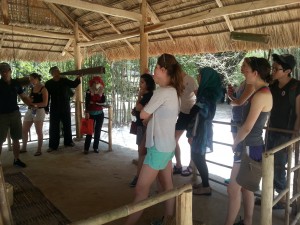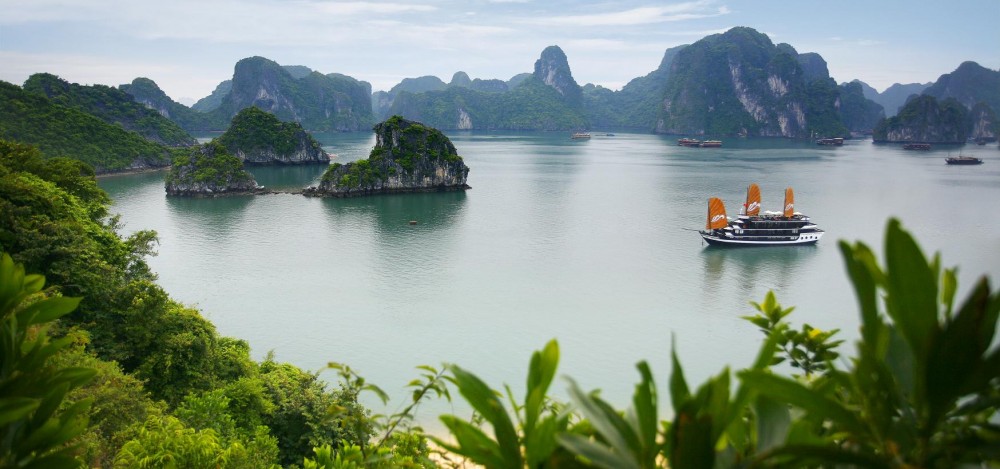 Throughout our visit to the Cu Chi Tunnels, I could not help but to be reminded time and time again of school trips and family visits to Greenfield Village, a local attraction near my house—just outside of Detroit—that is essentially a recreation of a U.S. colonial village. Moving from building to building around the recreation of the Vietnamese village, I found the focus was on the function of each house or building in the village during the war. However, at no point in the tour was the specific context of the war in Vietnam against Americans and the Republic of Vietnam mentioned, nor was the particular strategic significance of Cu Chi and its tunnels clarified. This wartime village, like the recreation of the colonial village I had visited in the U.S., was certainly interesting to see and gave me a better understanding of what daily life may have looked like during this period. Yet, the lack of context and indication of what made Cu Chi unique or important to the North Vietnamese struggle was missing. The tunnels themselves were similarly treated in a manner that was very separate from the greater context of the Vietnam War; their various functions and ingenuity were emphasized over any explanation for why they were built in that location, during what moments of the war were they particularly beneficial strategically, and more generally, why these particular tunnels should be remembered.
Throughout our visit to the Cu Chi Tunnels, I could not help but to be reminded time and time again of school trips and family visits to Greenfield Village, a local attraction near my house—just outside of Detroit—that is essentially a recreation of a U.S. colonial village. Moving from building to building around the recreation of the Vietnamese village, I found the focus was on the function of each house or building in the village during the war. However, at no point in the tour was the specific context of the war in Vietnam against Americans and the Republic of Vietnam mentioned, nor was the particular strategic significance of Cu Chi and its tunnels clarified. This wartime village, like the recreation of the colonial village I had visited in the U.S., was certainly interesting to see and gave me a better understanding of what daily life may have looked like during this period. Yet, the lack of context and indication of what made Cu Chi unique or important to the North Vietnamese struggle was missing. The tunnels themselves were similarly treated in a manner that was very separate from the greater context of the Vietnam War; their various functions and ingenuity were emphasized over any explanation for why they were built in that location, during what moments of the war were they particularly beneficial strategically, and more generally, why these particular tunnels should be remembered.
While there may be many reasons why visitors are encouraged to walk through the tunnels themselves, the primary one seems to be for entertainment. The tunnels have been made bigger and the length of the ones open to the public is extremely short. Though it was fun to pop out of the ground from these tunnels, my amusement was uncomfortably disconnected from any thoughts regarding the war and the soldiers’ experiences. It seems then that letting tourists engage with the tunnels in this way inherently undermines the site’s historical importance. The Cu Chi Tunnels made the active decision to make the experience more comfortable for visitors, which resulted in a trade off between the informational or thoughtful aspect of the visit and the entertainment factor.
Given my overall impression of the Cu Chi Tunnels as a fun attraction for tourists, rather than a commemoration of a strategically significant part of the North Vietnamese effort, the ideological propaganda video stood out as a stark contrast to the rest of the experience. The video in the middle of the tour put forward a very strong narrative of a peaceful Vietnam that was suddenly attacked by foreign (American) enemies, but heroically fought back in response to this invasion. The context of this video was once again missing and without any introduction of the video and its purpose for being shown, I interpreted the content as the historical narrative the site wished to put forth about the war. In contrast to enlarging the tunnels, mechanizing the exhibits, and providing a delicious peanut and sugar dip for the taro, this video was anything but comfortable or amusing, particularly for American tourists. The balance between the government’s desire to put forth their historical narrative and the oftentimes conflicting goal of attracting foreign tourists has been a common theme of the war museums and sites visited on the trip thus far. As the balance seems to tip more and more towards the latter mission, I wonder if the video at the Cu Chi Tunnels will get pushed to the periphery as it was at the Reunification Palace, to an easy to miss, side room located at the end of the tour. As time passes and perhaps guidebooks and other sources offer a more nuanced overview of the Vietnam War, I wonder too if the Vietnamese government’s ability and/or perception towards assigning a certain narrative to their war memorials and museums will remain so incompatible with attracting foreign tourists.
